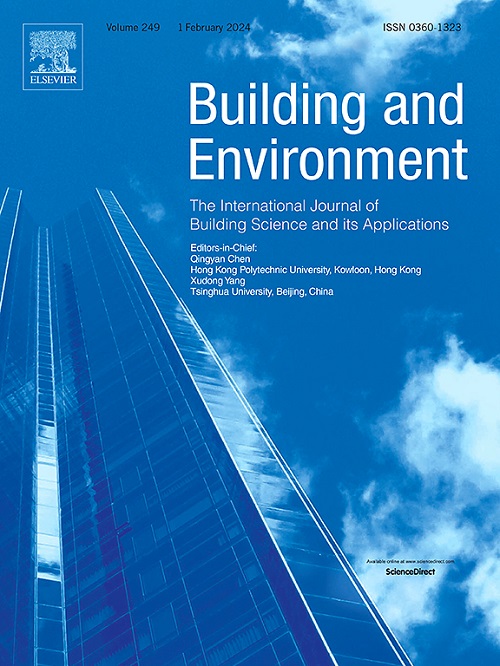采用不同通风策略的静态和动态室内环境中咳嗽飞沫的风险评估
IF 7.1
1区 工程技术
Q1 CONSTRUCTION & BUILDING TECHNOLOGY
引用次数: 0
摘要
在现实生活中,居住者通常会在房间里交替坐着和走动。人体运动引起的尾流会影响局部气流,增强局部混合效应,并增加空气的横向传播和远距离传播。本研究旨在全面比较在四种通风策略(即混合通风 (MV)、置换通风 (DV)、分层通风 (SV) 和分层置换通风 (SDV))下,人体移动对办公室内咳嗽飞沫扩散的影响。改进后的 Wells-Riley 模型用于计算易感人群在静态和动态室内环境中不同通风策略下的感染风险。结果表明,不同的通风策略以及有无人员流动都会对飞沫的扩散产生显著影响。当没有人体移动或人体移动靠近送风口时,易感人群在 SDV 下的感染风险最低,分别为 5.03 × 10-6 和 21.44 × 10-6。当人体远离送风口时,易感人群在感染阶段的感染风险与暴露时间几乎呈线性关系,四种通风方式的感染风险都很高。在降低室内交叉感染风险方面,SDV 性能最好,其次是 DV、SV,最后是 MV。这些结果可为静态和动态室内环境中的流行病控制提供参考。本文章由计算机程序翻译,如有差异,请以英文原文为准。
Risk assessment of cough droplets in both static and dynamic indoor environments with different ventilation strategies
In real-life scenarios, occupants typically alternate between sitting and walking in a room. The wake induced by human movement affects the local airflow, enhances local mixing effects, and increases airborne propagation laterally and across long distances. This study aimed to provide a comprehensive comparison of the impact of human movement on the dispersion of coughed droplets in an office under four ventilation strategies (i.e. Mixed Ventilation (MV), Displacement Ventilation (DV), Stratum Ventilation (SV) and Stratum Displacement Ventilation (SDV)). The improved Wells-Riley model was used to calculate the risk of infection for susceptible individuals in both static and dynamic indoor environments under different ventilation strategies. The results showed that different ventilation strategies, as well as the presence or absence of human movement, significantly affected the diffusion of droplets. When there was no human movement or human movement occurred close to the air supply, the risk of infection for susceptible individuals was lowest under SDV, 5.03 × 10−6 and 21.44 × 10−6, respectively. The risk of infection for susceptible individuals during the infection stage was almost linearly related to exposure time when human beings moved away from the air supply, and all four ventilation methods presented a high risk of infection. The SDV has the best performance, followed by DV, SV, and finally MV for reducing the risk of indoor cross infection. These results can provide a reference for epidemic control in both static and dynamic indoor environments.
求助全文
通过发布文献求助,成功后即可免费获取论文全文。
去求助
来源期刊

Building and Environment
工程技术-工程:环境
CiteScore
12.50
自引率
23.00%
发文量
1130
审稿时长
27 days
期刊介绍:
Building and Environment, an international journal, is dedicated to publishing original research papers, comprehensive review articles, editorials, and short communications in the fields of building science, urban physics, and human interaction with the indoor and outdoor built environment. The journal emphasizes innovative technologies and knowledge verified through measurement and analysis. It covers environmental performance across various spatial scales, from cities and communities to buildings and systems, fostering collaborative, multi-disciplinary research with broader significance.
 求助内容:
求助内容: 应助结果提醒方式:
应助结果提醒方式:


